Both confronting yet stimulating, whilst peaceful and inspiring, it's the contrasts that make India so special.
A melting pot of vibrant cultures and traditions, diverse landscapes and breathtaking architecture - there are endless things to see and do in India. You could lose yourself discovering the world-renowned textiles, fragrant spices and intricate handicrafts in the bustling markets, delving into the mouthwatering flavours of one of the world's greatest cuisines, or exploring the exquisitely designed temples and palaces. People watching is always a lot of fun too!
With so many fascinating and captivating places to visit in India, it can be hard narrowing down an itinerary, particularly if it's your first time travelling to India. To help make it easier, we've come up with eight places in India that you simply cannot afford to miss. Some in the North and some in the South, we hope this inspires your next India adventure!
1. Agra – Home of the The Taj Mahal
Agra is well known to be the home of the Taj Mahal – one of the Seven Wonders of the World and arguably one of the most beautiful buildings on Earth. Towering grandly and ever so elegantly over the bank of the Yamuna River, this delicate and intricately designed grand marble ivory-white mausoleum lives up to all its talked up to be and leaves few disappointed.
Whilst many visit Agra on a day trip to see the Taj Mahal alone and are on their way to their next destination soon after, there is more to Agra that people give it credit for. The Mughal Empire has left a wonderful fort and numerous captivating mausoleums and tombs. The Tomb of I’timad-ud-Daulah also known as the ‘Baby Taj’, is an exquisite tomb that is also worthwhile a visit in Agra. Less crowded and just as elegantly designed as Taj itself, it is well worth spending some time wondering through this tomb, appreciating the fine architecture, without the masses of people. You could spend several days visiting these monuments, as well as navigating your way through the lively marketplaces.
However, do be aware that with the flocks of tourists drawn to the Taj, comes many street sellers, rickshaw wallahs, touts and ‘fake’ guides which can get tiresome at times. All in all, Agra, is a must-see city in India, even if it is just for the Taj Mahal.
How to see it now
Tick Agra and the Taj Mahal off your bucket list on our five-day India’s Golden Triangle, where you will spend the morning at the Taj Mahal watching the sunrise as well as visit the Agra Fort, ‘the Baby Taj’ and participate in a marble inlay workshop.
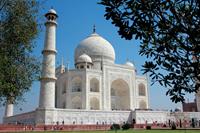
2. Jaipur – The Pink City
Jaipur was founded by Maharake Jai Singh in the early 18th century and is known as the “Pink City of India” - the gateway and capital to India’s most flamboyant state, Rajasthan. You will soon see why as you drive through the bustling city with almost every wall painted the colour pink, which was done to welcome Prince Edward VII and Queen Victoria in 1876. Jaipur is a delightful city, and is somewhat calmer than chaotic Delhi (but still pretty crazy!).
A big draw card to visit Jaipur is the historic fort-palace Amber Fort, nestled among the Aravalli Hills. Built in the 1600 by Raja Man Singh, this stunning fort will take your breath away! You could spend hours wondering through this fort marveling at the intricate and elaborate details in the buildings décor as well as enjoy learning about the story of the kingdom.
Another highlight of Jaipur is the decadent and magnificent City Palace which includes a huge complex of courtyards, gardens and buildings that are a fusion of Rajasthani and Mughal architecture, as well as a fascinating City Palace museum.
With it’s beautiful forts and palaces, Jaipur is sure to be a city that won’t disappoint!
How to see it now
Visit the highlights of Jaipur on our Classic North India trip where we will spend two days in Jaipur including time at Amber Fort, the City Palace museum full of fascinating ancient artifacts and Jai Singh’s Observatory. This trip is the perfect for those who want to soak up the biggest highlights of North India.
 Amber Fort
Amber Fort
3. Alleppey - peaceful Kerala Backwaters
If you have been travelling through North India, then the South of India, and in particular Kerala’s backwaters, comes as a welcomed break. These beautiful, picturesque backwaters must not be missed for those travelling in South India, and travel in all directions from the city of Alleppey (or Alappuzha), the hub of the surrounding backwaters.
The main attraction of the backwaters are the houseboats (also known as kettuvallams), with more than 2000 houseboats floating down the river. The kettuvallams were originally used as grain barges but have since been transformed into floating cottages – some being quite luxurious!
Alleppey itself is graceful and greenery-fringed, and is a watery world of villages, punted canoes, shops and many houseboats. Float along the backwaters and gaze over the vibrant green rice paddies, observe the village life, enjoy the mesmerizingly beautiful and relaxing experience and unwind from the chaos the rest of India brings.
How to see it now
There is no better way to visit Kerala than spending the night cruising peacefully down the backwaters on a traditional houseboat on our Highlights of Kerala trip. This relaxed introduction to the charming and diverse state of Kerala, after sightseeing in Cochin, allows you to soak up the lush tropical scenery and get a close-up glimpse of village life as you float down the backwaters.
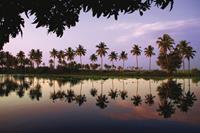
4. Varanasi - the holy city
Varanasi will be like no other city you have ever been to before – at the same time as being completely mind-boggling and chaotic on a whole new level, it is one incredibly fascinating and compelling place. Home to the famous River Ganges, an important centre of the Hindu universe, where many pilgrims come to wash away their sins or cremate their loves ones in the sacred waters. With public rituals of life and death, Varanasi is certainly not for the faint-hearted, although overwhelming it’s a city that is definitely worth a visit.
A walk along the ghats and a boat ride or evening ceremony is something to remember forever, as you watch Hindu pilgrims bathing in the waters of the sacred River Ganges, a ritual that washes away ones sins. It is also an auspicious place to die, as those who do are released from the cycle of rebirth. Spending time on the ghats is a moving experience like no other, and is something that will leave you in awe and complete fascination.
With scenes that may shock or inspire, and with a bustling chaos in the heart of the city like-no-other, Varanasi is a place of such cultural and spiritual significance that you simply must see it to believe it.
How to see it now
Spend two days in this holy city, on our 22-day North India in Depth trip, a cultural journey which will bring the complex history of the extraordinary country to life. In Varanasi you will have the opportunity to visit Sarnath, which is a major centre for Buddhism in India, full of monasteries and magnificent stupas. Arrive at the Ganges by dawn and be awed as you witness pilgrims bathing and praying in the city ghats at sunrise. End the day on the ghats being blown away by an evening performance of traditional music and dance.
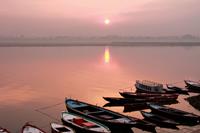
5. Delhi - a melting pot of the old and new
For most people, Delhi is their first taste of India when they exit the airport and have to navigate their way through the chaotic traffic to their hotel. Past the mayhem of India’s capital, which is home to a population of 25 million people – is a maze of mega malls, bustling markets, colonial buildings, Mughal mausoleums and fascinating relics of ancient empires.
Whilst some are underwhelmed by Delhi, if it’s given a chance, Delhi’s hidden corners will give you the most rewarding and memorable experiences. These might be wandering through the winding streets of the walled city of Old Delhi and marvelling at the remains of what once was the capital of the Mughals, filled with mansions, elegant mosques and gardens. There is something quaint and charming about the crumpling walls and chipped paint of what was once a grand building. Enjoy a free lunch and a sip of chai at a Sikh Temple and this will top off your day meandering through the organised chaos.
Along with exploring Old Delhi, there are many beautiful sights in Delhi which could take a good few days to see. You may even need a second visit to see all the monuments in Dehli. Some places of interest include the majestic Humayun’s Tomb, the old military barraks Red Fort, Jama Masjid (India’s largest mosque) and Mehrauli Archaeological Park (often overlooked by tourists).
How to see it now
Our Rajasthan Cycle tour combines the “Golden Triangle” cities of Delhi, Agra, and Jaipur with a wildlife-safari in Sariska Tiger Reserve and stop over at the Bharatpur Bird Sanctuary, perfect for travellers who would like to tick the big cities off their bucket list and see some wildlife too. Explore key monuments including the Taj Mahal, City Palace, the Jantar Mantar and the magnificent Red Fort. The cycling route follows the old road that was once a merchant route between the princely state of Alwar and Jaipur.

6. Udaipur - Venice of the East
With its shimmering lakes, grand marble palaces, temples, havelis and winding colourful streets - Udaipur is known as the “Venice of the East” and has been named one of India’s most romantic cities. This enchanting city is set on the man-made lake Lake Pichola against the woody Aravail Hills and was voted the best city in the world in 2009 by the Travel + Leisure magazine.
A highlight of Udaipur is the City Palace Complex and the City Palace Museum situated in the middle of Lake Pichola which houses a wonderful collection of traditional miniature paintings and is the largest palace complex in Rajasthan. A boat ride on Lake Pichola will give you a whole new perspective of the city.
Other highlights include exploring the architectural splendour of the Bagor Ki Haveli, watching the sunset over the Monsoon Palace, the Jagdish Temple - an imposing white Hundi temple with intricate architecture and carvings and the Ambrai Ghat - the perfect vantage point to photograph the city.
With its bustling ancient bazaars, vibrant art scene, quaint old buildings, winding narrow streets and beautiful country side, as well as wonderfully unique palaces and temples, this city full of character and zest is one not to be missed when travelling in India.
How to see it now
Experience this romantic city in depth on our Royal Rajasthan adventure allows you to explore the maze of narrow alleys and crooked lanes, taking in a number of significant architectural delights including the Garden of the Maids of Honour and the imposing City Palace (the largest of all of Rajasthan).
This two-week evocative tour will leave you in awe as you tour Rajasthan’s romantic past and ensuring splendour, visiting extraordinary forts, marvellous palaces and exquisite havelis, witnessing the ancient tales and stories from each city come to life.

7. Pondicherry - a taste of France in India
What do you do when you are craving some delectable French pastries while in India? Go to Pondicherry of course! Get a ‘taste of France’ in Pondicherry (also known as Puducherry) with delicious French food in this city which was under French rule until 1954. Pondicherry is a great place to sit down with a croissant and coffee by the sea; as you watch passers-by stroll down the picturesque foreshore, then perhaps relax with some afternoon yoga. While the modern part of Pondicherry is as busy as any other South India city, the older part, with its charming colonial-era teahouses, is calm, clean and relatively quiet and can give you a much needed break from the other bustling cities of Southern India.
Whether you spend the day shopping, sitting in a French bakery, or relaxing by the seaside, you are sure enjoy the vast contrast that Pondicherry brings in comparison to the big cities.
How to see it now
Indulge in some French pastries, and walk along the charming seaside of Pondicherry, while you experience this slice of France in India on our Ultimate Southern India Journey. This tour will take you on an in-depth exploration into lush and tropical Southern India with all its colour, vibrancy, spirituality and diversity.
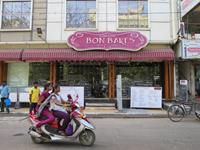
8. Leh - an enchanting desert city high in the Himalaya
Leh is the capital of Ladakh in northern India’s Jammu and Kashmir state and is a beautiful hassle free and enchanting desert city. High up in the Himalayas, 3500m above sea level, it is important to spend some time here acclimatising before you embark on any active adventures in the region. Leh is the gateway to many incredible treks and cycling adventures in the Indian Himalaya and is known for its Buddhist sights and the massive 17th century Leh Palace, which was modelled on the Dalai Lama’s former home. The palace is the most noticeable building in Leh, and is a great place to explore with dark and spooky corridors, and a gorgeous yet eerie Buddhist prayer room in the centre of the palace.
It’s easy to fall in love with Leh’s quaint charm, particularly in the Old Town, which is a patchwork of stupas and mud-brick houses, surrounded by maze-like laneways that lead to green fields. You could easily spend a couple of days in Leh, exploring the Buddhist temples and monasteries, or go on day trips to the Pangong Tso, a beautiful high altitude lake at 4350 metres with deep blue waters, the Nubra Valley, and the Victory fort.
How to see it now
Visit Leh on our Hidden Valleys of Ladakh trek, the perfect introduction to the breathtaking, culturally rich region of Ladakh. Start and end your scenic trek into the rugged land characterised by Buddhist and ancient forts in Leh, where you will spend time wandering the bazaar, visiting Victory Fort, and exploring the winding streets that soak up the quaint and charming atmosphere.
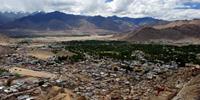
India with World Expeditions
World Expeditions operates many active adventures in India, from trekking high up in the Indian Himalaya to experiencing some of India's most famous cities. Browse our India trips here